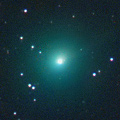
|
Getting brighter much faster than expected. Now it is so bright as 6.2 mag (Feb. 1, Chris Wyatt). It will approach to the sun down to 0.73 A.U. in March. It may brighten up to 3 mag at best. It is observable in good condition in the Southern Hemisphere. It is not observable now in the Northern Hemisphere. But it becomes observable again in May, and it keeps observable in good condition after that while fading gradually.
Date(TT) R.A. (2000) Decl. Delta r Elong. m1 Best Time(A, h)
Feb. 2 13 53.43 -82 51.8 0.990 1.207 75 6.0 5:02 ( 0,-28)
Feb. 9 22 40.31 -82 49.1 0.990 1.111 68 5.3 19:01 ( 9,-34)
|
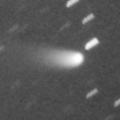
|
Now it is 6.5 mag (Feb. 1, Chris Wyatt). Although it had been brightening as expected until late December, the brightening has got slow down in January. It was expected to be a great comet of -1 mag in spring, however, it may brightens only up to 3 mag at best. In the Southern Hemisphere, it keeps observable in the low sky until mid February. In the Northern Hemisphere, it keeps unobservable for a long time until March.
Date(TT) R.A. (2000) Decl. Delta r Elong. m1 Best Time(A, h)
Feb. 2 19 27.44 -45 28.2 1.623 0.989 34 6.5 5:31 (315,-16)
Feb. 9 20 18.43 -45 24.9 1.451 0.843 34 5.9 5:26 (312,-20)
|

|
It brightened up to 9.0 mag in 2012 autumn (Nov. 4, Juan Jose Gonzalez). Appearing in the morning sky in the Southern Hemisphere. It keeps observable in good condition while fading slowly after this. In the Northern Hemisphere, it is hardly observable after 2013.
Date(TT) R.A. (2000) Decl. Delta r Elong. m1 Best Time(A, h)
Feb. 2 19 48.25 -36 14.8 2.688 1.847 25 9.1 5:31 (304,-14)
Feb. 9 20 10.69 -37 40.3 2.665 1.864 28 9.1 5:26 (306,-15)
|
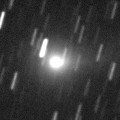
|
Long-lost comet for almost 200 years since 1827. Finally re-discovered by Rob Matson from SWAN images of mid November. Appearing in the morning sky again in the Northern Hemisphere. Now it is very bright as 9.3 mag (Jan. 31, Carlos Labordena). In the Northern Hemisphere, it keeps observable in excellent condition while fading after this. In the Southern Hemisphere, it is only observable in low sky from February to March.
Date(TT) R.A. (2000) Decl. Delta r Elong. m1 Best Time(A, h)
Feb. 2 18 29.68 5 43.6 1.626 1.144 43 9.1 5:31 (282, 26)
Feb. 9 18 23.26 9 52.6 1.549 1.230 52 9.5 5:26 (283, 34)
|
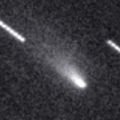
|
Not it is so bright as 10.5 mag (Jan. 31, Chris Wyatt). It became strongly condensed in outburst on Jan. 24. It approaches to the Sun down to 0.3 A.U. on Feb. 24. The ephemeris says it will brighten up to 7 mag. However, because the comet is small, it may be disintegrated. It locates extremely low in the Northern Hemisphere. It will be unobservable soon also in the Southern Hemisphere.
Date(TT) R.A. (2000) Decl. Delta r Elong. m1 Best Time(A, h)
Feb. 2 23 48.50 -30 49.9 1.014 0.688 40 10.9 18:55 ( 48, 3)
Feb. 9 23 24.77 -32 52.0 0.989 0.538 31 9.8 19:01 ( 55, -7)
|
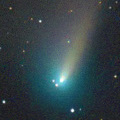
|
It approached to the earth down to 0.3 A.U. and brightened up to 7-8 mag from late December to early January. However, it will go away from the earth and fade out rapidly after this. It has already faded down to 12.4 mag (Jan. 28, Katsumi Yoshimoto). It is observable in good condition also in the Southern Hemisphere after this.
Date(TT) R.A. (2000) Decl. Delta r Elong. m1 Best Time(A, h)
Feb. 2 4 4.26 -11 21.9 0.997 1.531 101 11.9 19:13 ( 0, 44)
Feb. 9 4 3.90 -13 24.2 1.188 1.602 94 12.5 19:01 ( 5, 41)
|
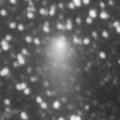
|
Now it is 11.2 mag (Jan. 20, Juan Jose Gonzalez). It is expected to be observable at 11-13 mag for a long time from 2012 summer to 2013 summer. It will be getting higher gradually in the morning sky. Finally it becomes observable also in the Northern Hemisphere.
Date(TT) R.A. (2000) Decl. Delta r Elong. m1 Best Time(A, h)
Feb. 2 16 14.52 -27 6.1 2.636 2.421 66 12.4 5:31 (333, 22)
Feb. 9 16 14.14 -25 19.5 2.544 2.463 74 12.4 5:26 (337, 26)
|

|
Now it is so bright as 11.8 mag (Jan. 3, Juan Jose Gonzalez). It keeps bright as 12 mag until spring. In the Northern Hemisphere, it keeps observable in good condition until April. It is not observable now in the Southern Hemisphere. It will become observable after April, but it keeps locating low.
Date(TT) R.A. (2000) Decl. Delta r Elong. m1 Best Time(A, h)
Feb. 2 1 35.26 50 0.9 1.744 1.999 89 12.7 18:55 (132, 62)
Feb. 9 1 54.59 46 8.0 1.760 1.940 84 12.6 19:01 (123, 61)
|

|
It brightened up to 11-12 mag in 2012. Now it is 13.5 mag (Jan. 16, A. Novichonok). It will be observable at 12-13 mag in good condition again in 2013.
Date(TT) R.A. (2000) Decl. Delta r Elong. m1 Best Time(A, h)
Feb. 2 15 31.97 -17 26.5 5.702 5.584 78 13.1 5:31 (339, 35)
Feb. 9 15 29.71 -17 26.6 5.590 5.604 85 13.1 5:26 (346, 36)
|

|
It kept as bright as 6-7 mag for a long time from 2011 summer to 2012 spring. Now it is fading. But it is very bright and visible visually at 14.0 mag still now (Dec. 13, Sandor Szabo).
Date(TT) R.A. (2000) Decl. Delta r Elong. m1 Best Time(A, h)
Feb. 2 9 0.11 -10 58.9 4.056 4.948 152 13.5 0:13 ( 0, 44)
Feb. 9 8 52.08 -10 54.5 4.115 5.012 152 13.6 23:32 ( 0, 44)
|
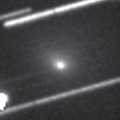
|
First return of a new periodic comet discovered in 1994. Although it had been fainter than expected, it brightened rapidly and reached up to 10.6 mag (Dec. 13, Katsumi Yoshimoto). It is bright as 11.6 mag still now (Jan. 11, Sandor Szabo). It has a large diffuse coma. It keeps locating high for a while, but it will be fading after this.
Date(TT) R.A. (2000) Decl. Delta r Elong. m1 Best Time(A, h)
Feb. 2 2 26.73 -7 14.2 1.340 1.510 79 13.6 18:55 ( 27, 44)
Feb. 9 2 48.62 -6 39.3 1.427 1.560 78 14.0 19:01 ( 32, 43)
|

|
It brightened rapidly, and reached up to 12 mag in 2012. Appearing in the mornig sky again. It will be observable at 12-14 mag in good condition again in 2013. However, it locates somewhat low in the Northern Hemisphere in 2013. By the way, Juan Jose Gonzalez reported it is extremely bright as 9.6 mag on Jan. 20.
Date(TT) R.A. (2000) Decl. Delta r Elong. m1 Best Time(A, h)
Feb. 2 17 58.56 -22 48.0 3.514 2.880 43 13.7 5:31 (310, 12)
Feb. 9 18 10.08 -23 8.1 3.447 2.880 47 13.7 5:26 (312, 14)
|
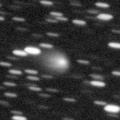
|
Now it is 13.3 mag (Nov. 15, Sandor Szabo). It keeps bright at 13-14 mag for a long time until 2014. It keeps observable for a long time in the Northern Hemisphere. It is not observable in the Southern Hemisphere.
Date(TT) R.A. (2000) Decl. Delta r Elong. m1 Best Time(A, h)
Feb. 2 21 0.82 29 55.1 6.580 5.949 46 13.7 5:31 (240, 9)
Feb. 9 21 3.71 29 41.9 6.600 5.943 44 13.7 5:26 (242, 13)
|

|
Juan Jose Gonzalez reported it is extremely bright as 10.5 mag on Jan. 20. However, it is extremely diffuse.
Date(TT) R.A. (2000) Decl. Delta r Elong. m1 Best Time(A, h)
Feb. 2 14 10.90 -23 8.3 6.074 6.232 94 13.9 5:22 ( 0, 32)
Feb. 9 14 11.81 -23 25.2 5.961 6.231 101 13.8 4:56 ( 0, 32)
|

|
Big asteroid discovered in 1906. It suddenly showed the cometary activity on Dec. 11, 2010, probably due to an impact of a small object. Now it is 11.9 mag (May 29, Marco Goiato). It has already turned to be stellar. It is not observable now.
Date(TT) R.A. (2000) Decl. Delta r Elong. m1 Best Time(A, h)
Feb. 2 21 14.95 -25 59.5 3.647 2.680 9 14.2 18:55 ( 72,-20)
Feb. 9 21 28.20 -25 10.3 3.655 2.691 10 14.2 5:26 (285,-23)
|
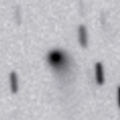
|
It is expected to keep 13 mag and observable in good condition in the Northern Hemisphere for a long time from 2013 to 2014. Now it is 15.0 mag (Jan. 9, A. Novichonok). It will be observable also in the Southern Hemisphere from early December to early March, although it locates low.
Date(TT) R.A. (2000) Decl. Delta r Elong. m1 Best Time(A, h)
Feb. 2 11 9.06 35 40.1 3.679 4.531 146 14.4 2:21 (180, 89)
Feb. 9 11 0.81 37 49.6 3.614 4.492 149 14.3 1:46 (180, 87)
|

|
Now it is bright and visible visually at 12.9 mag (Jan. 3, Chris Wyatt). It keeps 12-14 mag until February. It keeps observable in good condition in the Northern Hemisphere. In the Southern Hemisphere, it locates extremely low, and will be unobservable soon.
Date(TT) R.A. (2000) Decl. Delta r Elong. m1 Best Time(A, h)
Feb. 2 1 8.03 17 48.8 3.412 3.206 69 14.4 18:55 ( 74, 51)
Feb. 9 1 18.02 17 37.8 3.513 3.218 64 14.5 19:01 ( 79, 46)
|

|
Now it is 14.9 mag (Jan. 5, A. Novichonok). It will be fading slowly after this. But it keeps 15 mag in 2013. It is observable in good condition in the Southern Hemisphere. It becomes observable in the extremely low sky from January to February in the Northern Hemisphere.
Date(TT) R.A. (2000) Decl. Delta r Elong. m1 Best Time(A, h)
Feb. 2 2 55.53 -43 10.0 6.319 6.179 77 14.4 18:55 ( 9, 11)
Feb. 9 2 55.83 -41 38.4 6.404 6.202 73 14.4 19:01 ( 16, 11)
|

|
Now it is 14.9 mag (Jan. 11, V. Gerke, S. Plaksa, A. Novichonok). It is fainter than originally predicted by 1 mag. It will brighten up to 14 mag until spring. In the Northern Hemisphere, it keeps observable in excellent condition. In the Southern Hemisphere, it keeps locating extremely low for a while.
Date(TT) R.A. (2000) Decl. Delta r Elong. m1 Best Time(A, h)
Feb. 2 10 21.22 36 11.9 1.131 2.062 153 14.7 1:34 (180, 89)
Feb. 9 10 14.79 35 38.4 1.096 2.041 156 14.5 1:00 (180, 89)
|
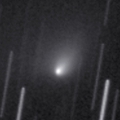
|
Now it is visible visually at 13.7 mag (Dec. 23, Juan Jose Gonzalez). It keeps 15 mag until March. In the Northern Hemisphere, it keeps observable for a long time until the comet fades out. It is not observable in the Southern Hemisphere, except for 2013 spring, but the comet locates extremely low only.
Date(TT) R.A. (2000) Decl. Delta r Elong. m1 Best Time(A, h)
Feb. 2 3 35.46 51 52.4 1.797 2.305 108 14.9 18:55 (175, 73)
Feb. 9 3 42.22 46 54.3 1.896 2.321 102 15.0 19:01 (152, 76)
|
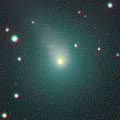
|
It brightened much faster than expected, and reached up to 10.0 mag in summer (Aug. 9, Juan Jose Gonzalez). Now it is fading, but it is bright as 13.8 ma still now (Jan. 11, Sandor Szabo). It keeps observable in good condition for a while after this.
Date(TT) R.A. (2000) Decl. Delta r Elong. m1 Best Time(A, h)
Feb. 2 7 16.18 9 24.7 2.163 3.074 153 15.1 22:24 ( 0, 64)
Feb. 9 7 4.29 8 9.0 2.279 3.128 143 15.4 21:45 ( 0, 63)
|
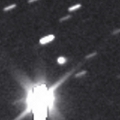
|
Now it is 15.2 mag (Jan. 11, Sandor Szabo). Already visible visually. It is expected to be a great comet in 2013 autumn when the comet approaches to the sun down to only 0.01 A.U. It keeps visible with naked eyes from November to January, and can be extremely bright as Venus or more at the highlight. The condition is excellent in the Northern Hemisphere. It keeps observable almost all through the period of brightening, at the highlight, and of fading. The condition is not good in the Southern Hemisphere. It is not observable at all the latter part of the highlight, and it keeps low all through the period.
Date(TT) R.A. (2000) Decl. Delta r Elong. m1 Best Time(A, h)
Feb. 2 7 16.42 31 44.5 4.026 4.917 151 15.4 22:25 ( 0, 87)
Feb. 9 7 8.93 31 46.9 4.011 4.840 143 15.4 21:50 ( 0, 87)
|

|
Now it is 16.8 mag (Jan. 19, K. Hills). It keeps bright as 13-14 mag for a long time from 2013 to 2014.
Date(TT) R.A. (2000) Decl. Delta r Elong. m1 Best Time(A, h)
Feb. 2 14 41.55 -10 22.3 3.449 3.618 91 15.7 5:31 (353, 44)
Feb. 9 14 45.29 -10 38.8 3.331 3.603 97 15.6 5:26 (359, 44)
|

|
New bright comet discovered at 15 mag in late December. Now it is 16.4 mag (Jan. 21, K. Hills). It must have been bright as 13-14 mag and observable in good condition from spring to autumn in the Southern Hemisphere. But it was not discovered. It will be fainter than 18 mag in April, and keeps observable in good condition. It will be observable also in the Northern Hemisphere after this in the evening sky while fading gradually.
Date(TT) R.A. (2000) Decl. Delta r Elong. m1 Best Time(A, h)
Feb. 2 5 12.06 -41 35.1 2.237 2.611 101 15.9 20:21 ( 0, 14)
Feb. 9 5 12.70 -37 36.2 2.313 2.669 100 16.1 19:54 ( 0, 18)
|
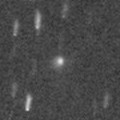
|
Now it is 15.6 mag (Jan. 23, W. Hasubick). It will brighten up to 12 mag from summer to autumn in 2013. In the Northern Hemisphere, it is observable only until spring when the comet brightens up to 15 mag. In the Southern Hemisphere, it keeps unobservable until August. Then it keeps observable while fading gradually.
Date(TT) R.A. (2000) Decl. Delta r Elong. m1 Best Time(A, h)
Feb. 2 23 54.59 52 15.2 2.971 2.939 78 16.0 18:55 (132, 46)
Feb. 9 0 11.17 50 60.0 2.970 2.868 74 15.9 19:01 (130, 43)
|

|
Now it is 16.2 mag (Dec. 25, K. Hills). In the Southern Hemisphere, it will be observable at 15-16 mag in good condition for a long time until 2013 summer. It is not observable at all in the Northern Hemisphere.
Date(TT) R.A. (2000) Decl. Delta r Elong. m1 Best Time(A, h)
Feb. 2 0 49.90 -68 17.9 4.516 4.152 62 16.0 18:55 ( 16,-18)
Feb. 9 1 7.73 -66 35.2 4.532 4.173 62 16.0 19:01 ( 18,-18)
|

|
Now it is 14.8 mag (Jan. 9, A. Novichonok). It keeps 15-16 mag until February. It keeps observable in good condition for a long time until the comet fades out in the Northern Hemisphere. It is not observable until 2013 summer in the Southern Hemisphere. By the way, Juan Jose Gonzalez reported it extremely bright as 10.4 mag visually on Nov. 6.
Date(TT) R.A. (2000) Decl. Delta r Elong. m1 Best Time(A, h)
Feb. 2 0 34.04 54 5.4 3.596 3.629 84 16.0 18:55 (135, 52)
Feb. 9 0 40.35 51 54.4 3.714 3.644 78 16.1 19:01 (131, 48)
|

|
Now it is 17.5 mag (Jan. 17, Hidetaka Sato). It keeps observable at 16 mag in the morning sky from February to April.
Date(TT) R.A. (2000) Decl. Delta r Elong. m1 Best Time(A, h)
Feb. 2 17 24.69 -15 25.8 1.926 1.533 52 16.6 5:31 (311, 23)
Feb. 9 17 47.21 -15 24.9 1.888 1.528 53 16.4 5:26 (311, 23)
|

|
It kept as bright as 11-12 mag for a long time from 2011 autumn to 2012 spring. Now it is fading. It has already faded down to 17.0 mag (Jan. 11, V. Gerke, S. Plaksa, A. Novichonok). It keeps observable in good condition until spring while the comet will be fading gradually.
Date(TT) R.A. (2000) Decl. Delta r Elong. m1 Best Time(A, h)
Feb. 2 10 25.24 1 53.3 2.481 3.398 154 16.5 1:37 ( 0, 57)
Feb. 9 10 20.29 2 21.9 2.475 3.429 162 16.6 1:05 ( 0, 57)
|

|
It reaches up to 15-16 mag from spring to summer. It is observable in excellent condition in the Southern Hemisphere. It locates low in the Northern Hemisphere. No observations have been reported since last September.
Date(TT) R.A. (2000) Decl. Delta r Elong. m1 Best Time(A, h)
Feb. 2 16 52.68 -49 20.7 3.901 3.503 59 16.9 5:31 (336, -1)
Feb. 9 16 51.86 -49 22.6 3.774 3.485 65 16.8 5:26 (340, 1)
|
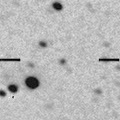
|
Now it is 16.4 mag (Jan. 6, J. F. Hernandez). It is expected to brighten up to 6 mag in 2014 autumn. In 2013, it keeps observable in good condition until autumn when it brigthens up to 14 mag.
Date(TT) R.A. (2000) Decl. Delta r Elong. m1 Best Time(A, h)
Feb. 2 17 28.19 9 14.9 7.139 6.685 59 17.0 5:31 (289, 40)
Feb. 9 17 30.04 9 42.4 6.991 6.624 64 16.9 5:26 (293, 44)
|

|
Now it is 17.4 mag (Jan. 5, K. Hills). It keeps observable in good condition at 17 mag from January to June. It locates somewhat low in the Southern Hemisphere.
Date(TT) R.A. (2000) Decl. Delta r Elong. m1 Best Time(A, h)
Feb. 2 9 14.71 18 12.4 1.151 2.136 176 17.1 0:27 ( 0, 73)
Feb. 9 9 9.63 19 6.8 1.131 2.114 173 17.0 23:50 ( 0, 74)
|
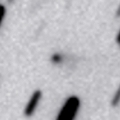
|
It was identified with an old comet discovered in 1931 by Tombaugh. It was unusually bright as 12.5 mag in 1931. Now it is 16.9 mag (Jan. 19, Y. Sugiyama). It keeps 17.5 mag until March, and keeps observable in excellent condition in the Northern Hemisphere. It locates low in the Southern Hemisphere.
Date(TT) R.A. (2000) Decl. Delta r Elong. m1 Best Time(A, h)
Feb. 2 6 43.66 35 58.6 1.581 2.447 143 17.4 21:52 (180, 89)
Feb. 9 6 41.75 36 21.5 1.630 2.444 136 17.4 21:23 (180, 89)
|

|
Now it is 17.2 mag (Dec. 31, Yasukazu Ikari). It will be observable at 17-18 mag for a long time from 2013 to 2014.
Date(TT) R.A. (2000) Decl. Delta r Elong. m1 Best Time(A, h)
Feb. 2 12 23.26 4 30.0 3.245 3.944 129 17.5 3:35 ( 0, 59)
Feb. 9 12 22.55 4 36.9 3.160 3.934 136 17.4 3:07 ( 0, 60)
|
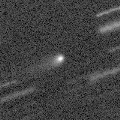
|
Now it is 17.8 mag (Jan. 11, P. Dupouy, et al.). It brightened up to 16.5 mag in 2012. It will be observable in good condition again at 17.5 mag in 2013 spring.
Date(TT) R.A. (2000) Decl. Delta r Elong. m1 Best Time(A, h)
Feb. 2 14 13.81 2 37.6 5.636 5.926 102 17.5 5:25 ( 0, 58)
Feb. 9 14 10.06 3 6.1 5.528 5.942 110 17.5 4:54 ( 0, 58)
|

|
It is expected to brighten up to 11 mag and become observable in excellent condition in 2014 spring. Now it is 17.9 mag (Jan. 3, Toshiyuki Takahashi). In the Northern Hemisphere, it keeps observable in good condition until early summer. It locates low in the Southern Hemisphere.
Date(TT) R.A. (2000) Decl. Delta r Elong. m1 Best Time(A, h)
Feb. 2 9 12.33 37 4.6 3.769 4.706 159 17.6 0:25 (180, 88)
Feb. 9 9 6.53 37 56.1 3.723 4.643 156 17.5 23:47 (180, 87)
|

|
It brightened very rapidly, became much brighter than originally expected, and reached up to 11-12 mag from summer to autumn in 2012. Now it is fading. It has already faded down to 17.1 mag (Jan. 17, J. F. Soulier). It keeps high for a long time in the Northern Hemisphere. It locates very low in the Southern Hemisphere.
Date(TT) R.A. (2000) Decl. Delta r Elong. m1 Best Time(A, h)
Feb. 2 3 6.94 38 18.0 1.658 2.087 101 17.6 18:55 (116, 82)
Feb. 9 3 20.78 38 6.1 1.771 2.132 97 18.0 19:01 (109, 78)
|
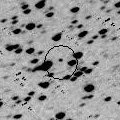
|
Peculiar asteroid moving along a cometary orbit. Now it is 17.3 mag (Dec. 6, E. Cozzi). It keeps observable at 18 mag for a long time from 2008 to 2014. It locates extremely low in the Southern Hemisphere.
Date(TT) R.A. (2000) Decl. Delta r Elong. m1 Best Time(A, h)
Feb. 2 7 10.32 41 47.8 6.354 7.187 145 17.7 22:19 (180, 83)
Feb. 9 7 4.90 42 9.6 6.432 7.200 138 17.8 21:46 (180, 83)
|
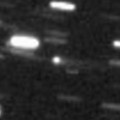
|
Now it is 17.7 mag (Jan. 11, V. Gerke, S. Plaksa, A. Novichonok). It reached up to 17 mag in last winter between 2011 and 2012. It will be observable in good condition again at 17.5 mag in this winter.
Date(TT) R.A. (2000) Decl. Delta r Elong. m1 Best Time(A, h)
Feb. 2 9 26.21 16 57.3 3.189 4.171 174 17.7 0:39 ( 0, 72)
Feb. 9 9 21.91 17 15.1 3.194 4.180 176 17.7 0:07 ( 0, 72)
|

|
It brightened very rapidly and unusually, and reached up to 10 mag in 2012 autumn. Now it is fading. It has already faded down to 17.0 mag (Jan. 11, A. Diepvens). .It keeps high for a long time in the Northern Hemisphere. It is not observable after this in the Southern Hemisphere.
Date(TT) R.A. (2000) Decl. Delta r Elong. m1 Best Time(A, h)
Feb. 2 2 31.10 44 0.8 1.559 1.933 96 17.9 18:55 (128, 73)
Feb. 9 2 49.84 44 1.0 1.664 1.980 93 18.6 19:01 (125, 71)
|
|
![]()
 C/2012 V2 ( LINEAR )
C/2012 V2 ( LINEAR ) C/2011 O1 ( LINEAR )
C/2011 O1 ( LINEAR ) C/2012 A2 ( LINEAR )
C/2012 A2 ( LINEAR ) 125P/Spacewatch
125P/Spacewatch 78P/Gehrels 2
78P/Gehrels 2 C/2012 K6 ( McNaught )
C/2012 K6 ( McNaught ) C/2012 K1 ( PanSTARRS )
C/2012 K1 ( PanSTARRS ) 175P/Hergenrother
175P/Hergenrother 274P/2012 WX32 ( Tombaugh-Tenagra )
274P/2012 WX32 ( Tombaugh-Tenagra ) P/2012 B1 ( PanSTARRS )
P/2012 B1 ( PanSTARRS ) C/2010 R1 ( LINEAR )
C/2010 R1 ( LINEAR ) C/2012 X1 ( LINEAR )
C/2012 X1 ( LINEAR ) 260P/2012 K2 ( McNaught )
260P/2012 K2 ( McNaught ) (342842) 2008 YB3
(342842) 2008 YB3 244P/2010 Q1 ( Scotti )
244P/2010 Q1 ( Scotti ) 168P/Hergenrother
168P/Hergenrother![]()



































